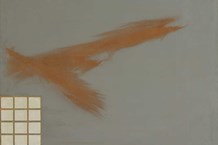Young Man Holding a Roundel had an estimate in excess of $80m and drew interest from two bidders – one on the phone to Lilija Sitnika, Sotheby’s London-based senior liaison for Russian clients, and the other to Alex Bell, the co-chairman of the auction house’s global Old Master Paintings department who was based in New York for the sale but bidding for an Asian collector.
The competition was somewhat muted and did not encroach far into the estimate, but the price was still the second highest for an Old Master sold at auction, only behind Leonardo da Vinci’s Salvator Mundi that was knocked down at $400m ($450m with premium added) at Christie’s New York in November 2017.
It was also by far and away the highest for Botticelli at auction, outselling the $9.25m (£5.88m) bid for The Rockefeller Madonna that sold at Christie’s New York in January 2013 which held the previous record.
Only around 50 paintings either wholly or partly by Botticelli are known to have survived. While few fully-attributed works by the great Renaissance artist have ever emerged at auction, Young Man Holding a Roundel was described by the auction house as comparable “in its inventiveness and superb quality” to some of Botticelli’s finest portraits. Only 12 portraits by the artist are recorded of which three, including this example, remain in private hands.
The work was widely reported to have been consigned to Sotheby’s from the collection of US property billionaire Sheldon Solow. A major art collector, he died aged 92 in November and had bought Young Man Holding a Roundel at Christie’s London in 1982 for £810,000 when it was sold by the heirs of Thomas Ralph Merton who had bought it in 1941 for £17,000.
Attribution
Over the years the picture’s attribution has been a source of some conjecture among scholars and it had previously been ascribed to Francesco Botticini (1446-1498) as well as the school of Botticelli, rather than the master. However, in 1987, it was endorsed by the art historian Richard Stapleford who believed it to be an autograph work from the early 1480s executed during Botticelli’s time in Rome or in the two or three years following.
He wrote: “The power of Botticelli’s portrait lies in his ability to express the exquisite beauty inherent in life while simultaneously confronting the fragility of that beauty.”
Furthermore Sotheby’s undertook new technical analysis that seemingly further contributed to their confident attribution – X-rays and infra-red reflectograms indicated a structure of incised circles and lines that the auctioneers said were characteristic of Botticelli’s method of plotting out his compositions.
They also revealed extensive underdrawing that differed in certain ways from the finished painting. Sotheby’s said it showed “a process of continuous revision is symptomatic of the perfectionist quest for the ideal that is a hallmark of his art”.
In terms of its earlier provenance, its first securely recorded known owner was Lord Newborough in the 1930s who kept it as part of his collection at Caernarvon in Wales. It is believed to have come to the UK via his ancestor Sir Thomas Wynn, 1st Lord Newborough (1736-1807) who lived in Tuscany.
Between 1935-38, the portrait passed though London dealer Frank Sabin and it was bought by Sir Thomas Ralph Merton in 1941 for £17,000. It was Merton’s heirs who sold it at the 1982 auction.
In the past 50 years, the painting has been on loan for extended periods at the National Gallery in London, the National Gallery of Art, Washington, DC and most recently the Metropolitan Museum of Art in New York where it was hanging until February last year.
It has also featured in major exhibitions at the Royal Academy, the National Gallery of Art, Washington and the Städel Museum, Frankfurt am Main.
In terms of the most expensive Old Masters ever sold at auction, the picture may be some way behind the Leonardo but stands ahead of two works by Peter Paul Rubens (1577-1640) that both sold in London: The Massacre of the Innocents that took £45m at Sotheby’s in July 2002 and Lot and his Daughters that made £40m at Christie’s London in July 2016.
The other anticipated highlight of the current sale however, Rembrandt's Abraham and the Angels which was estimated at $20-30m, was withdrawn.
Sotheby’s said in a statement: "The painting was withdrawn following discussions with the consignor. It’s a fabulous work – one of the finest by the artist ever to appear on the market – and was much admired by viewers around the world prior to the sale. While we didn’t get to see it sell in the room tonight, it will nonetheless find a new home very soon."
The fees payable at Sotheby’s are 25/20/13.9% buyer’s premium plus 1% overhead premium.
£1 = $1.37






